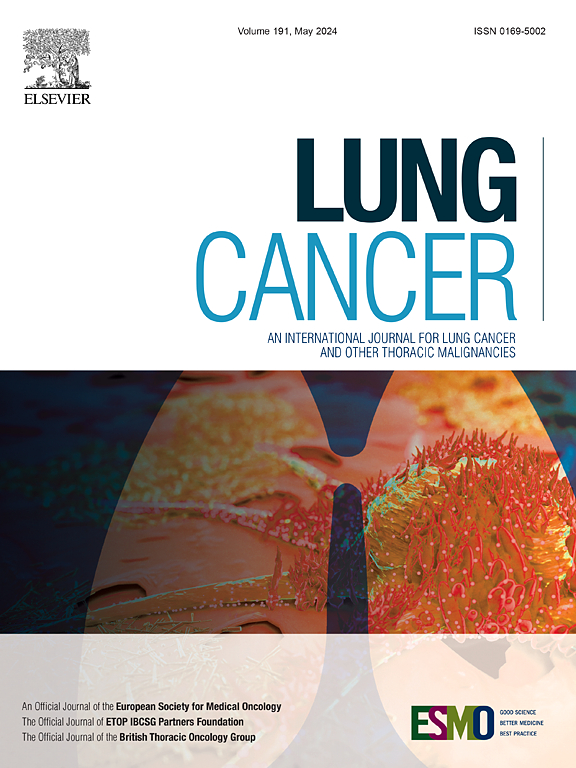低剂量计算机断层扫描肺癌筛查在高危人群(前)吸烟者在比利时的经济评价
IF 4.4
2区 医学
Q1 ONCOLOGY
引用次数: 0
摘要
背景:在实施筛查计划之前,重要的是要权衡利弊并评估其成本效益。迄今为止,比利时还没有对肺癌筛查进行过这样的评估。本研究的目的是检查在比利时(前)吸烟者人群中使用低剂量CT (LDCT)进行肺癌筛查的成本效益。该经济评估基于NELSON试验的结果,并辅以比利时分期和组织学特异性生存数据、比利时真实世界的诊断和治疗成本以及文献信息(如生活质量)。通过将决策树(邀请、筛选和诊断)与马尔可夫模型(干预组和比较组中检测到的癌症)相结合,对增量成本和效果进行建模。结果表示为每质量调整生命年(QALYs)的成本。收益和危害也以1000人的数字呈现。研究结果:基于NELSON筛查策略,与不筛查相比,三轮LDCT筛查肺癌(在第0、1和3年)与4.6 QALYs的增量收益和每100名参与者的增量成本7.8万欧元相关。这导致每获得一个质量质量的增量成本效益比为18 530欧元。在比利时的医疗环境中,如果政策制定者愿意为每个获得的QALY支付超过2万欧元,那么LDCT筛查(前)吸烟者的肺癌可能具有成本效益。然而,在实施肺癌筛查之前,重要的是要深入了解偶然发现的影响、可用预算和医疗保健系统的能力。当个人被充分告知LDCT肺癌筛查的益处和危害时,评估参与意愿也很重要。本文章由计算机程序翻译,如有差异,请以英文原文为准。
An economic evaluation of lung cancer screening with low-dose computed tomography in a high-risk population of (ex-)smokers in Belgium
Background
Before implementing a screening programme, it is important to balance the benefits against the harms and assess its cost-effectiveness. To date, no such evaluation of lung cancer screening has been conducted in Belgium. The objective of this study was to examine the cost-effectiveness of lung cancer screening using low-dose CT (LDCT) in a Belgian population of (ex-)smokers.
Methods
This economic evaluation is based on the results of the NELSON trial and supplemented with Belgian stage- and histology-specific survival data, Belgian real-world diagnosis and treatment costs, and information from the literature (e.g. quality of life). Incremental costs and effects were modelled by combining a decision tree (invitation, screening and diagnosis) with a Markov model (cancers detected in the intervention and comparator group). The results are expressed as costs per quality-adjusted life years (QALYs). Benefits and harms are also presented on a 1000-person figure.
Findings
Based on the NELSON screening strategy, three rounds of LDCT screening for lung cancer (in years 0, 1 and 3) compared to no screening is associated with an incremental gain of 4.6 QALYs and an incremental cost of €78 000 per 100 participants. This results in an incremental cost-effectiveness ratio of €18 530 per QALY gained.
Interpretation
In the Belgian healthcare setting, LDCT screening of (ex-)smokers for lung cancer is likely to be cost-effective if policy makers are willing to pay more than €20 000 per QALY gained. However, before implementing lung cancer screening, it is important to gain insight into the impact of incidental findings, available budgets, and capacity within the healthcare system. It is also important to evaluate the willingness to participate when individuals are fully informed about the benefits and harms of LDCT lung cancer screening.
求助全文
通过发布文献求助,成功后即可免费获取论文全文。
去求助
来源期刊

Lung Cancer
医学-呼吸系统
CiteScore
9.40
自引率
3.80%
发文量
407
审稿时长
25 days
期刊介绍:
Lung Cancer is an international publication covering the clinical, translational and basic science of malignancies of the lung and chest region.Original research articles, early reports, review articles, editorials and correspondence covering the prevention, epidemiology and etiology, basic biology, pathology, clinical assessment, surgery, chemotherapy, radiotherapy, combined treatment modalities, other treatment modalities and outcomes of lung cancer are welcome.
 求助内容:
求助内容: 应助结果提醒方式:
应助结果提醒方式:


